Fittonia come in a rainbow of colours but are notorious for being a pretty fussy plant. When I shared a photo of my plant at the end of last year over on my instagram, I received LOTS of messages asking how I have kept mine alive for so many years + for a blogpost that shares my care tips for this plant genus. They are often called nerve plants or mosaic plants because of their striking leaf patterning + these pots are also sometimes less commonly referred to as a ‘silver net leaf’ or ‘painted net leaf’ in reference to the brighter varieties, because up close, that is actually quite an accurate description of their appearance! If you or someone you know loves jewel orchids that are grown for their foliage (more than their flowers) like Ludisia discolor + Macodes petola, Fittonia leaves are along the same line with the bright veining + humidity loving needs:
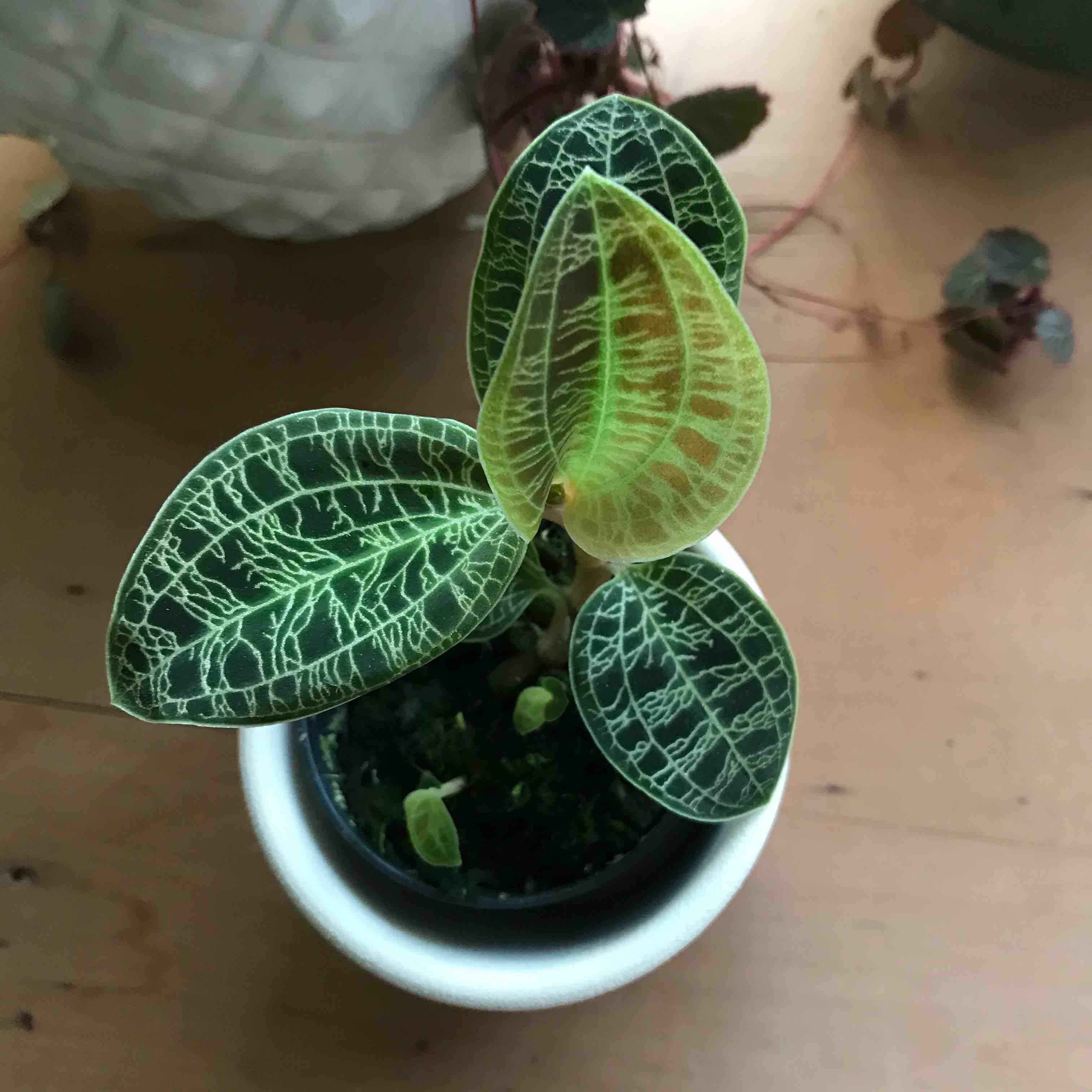
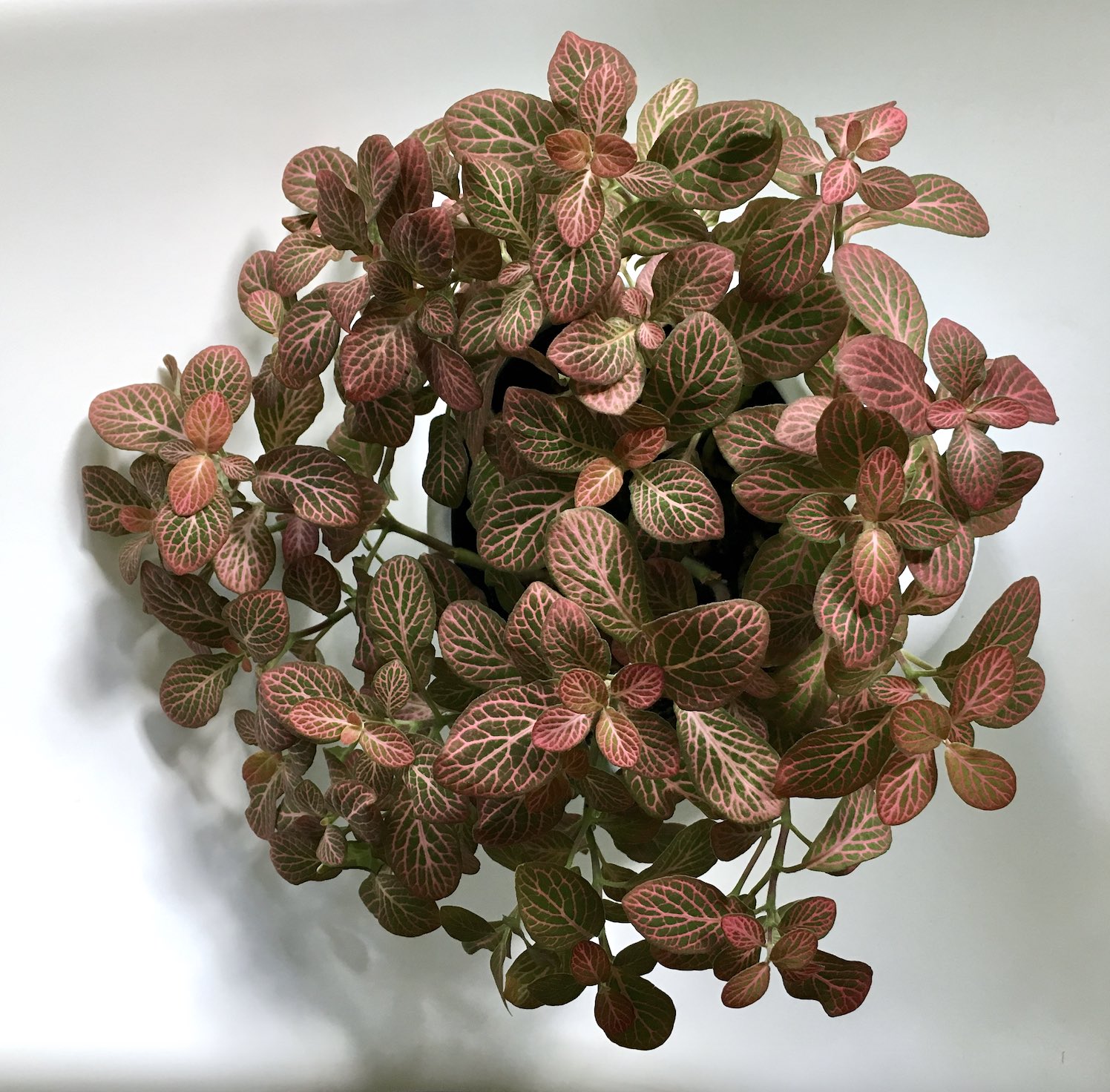
Above: A lovely-leaved pair —My Macodes petola + Fittonia today. The plant was named after Elizabeth + Sarah Mary Fitton — from my A – Z of Houseplants:
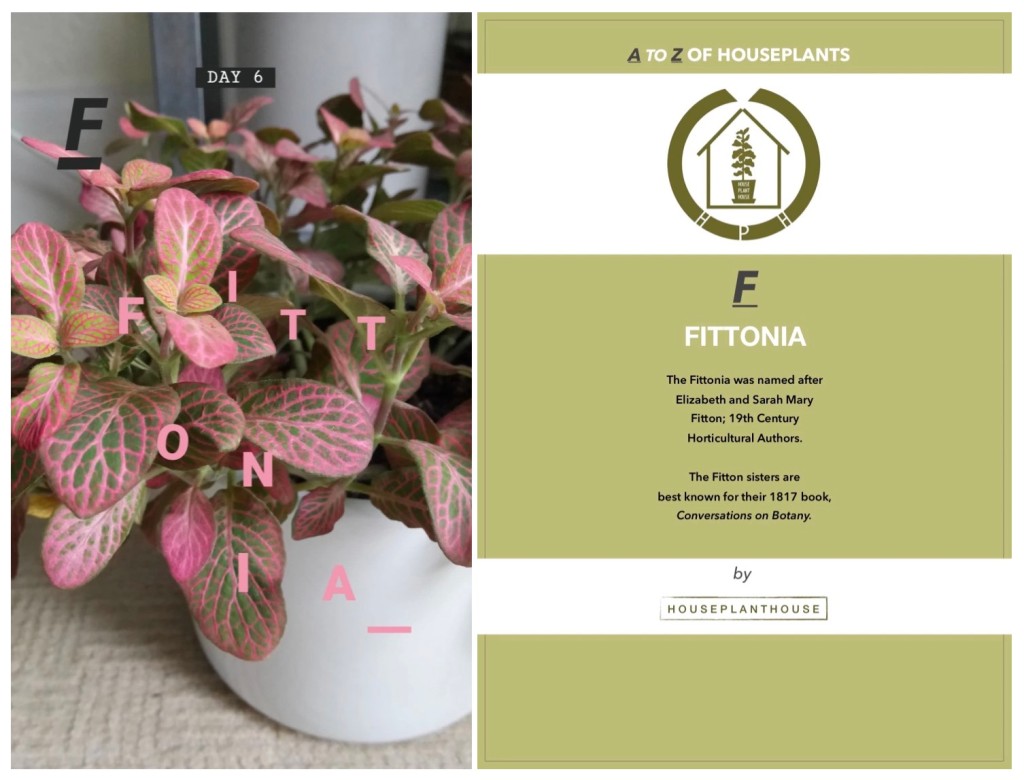
I’d been blogging for just a few months when I picked up this plant one cold winter evening + I remember thinking ‘ok Laura, you’d better take lots of photos of this before it crisps up‘… I didn’t have much confidence in my ability to care for it, but I wanted the challenge of something more delicate, with thinner leaves. Fittonia are beautiful houseplants that offer something different to your standard green/tall/leafy variety + I’ve noticed that my customers who also do well with ferns + enjoy the colourful begonias often make a bee-line for these displays!
If you love the look of a polka dot plant (Hypoestes phyllostachya) but find them too difficult, I think Fittonia are a great alternative + more amenable to moderate household humidity, with slightly thicker leaves. I have had my plant for nearly 4 years + here’s a comparison from the day I bought it, to now — Aside from the growth…look how much the colour has changed too!
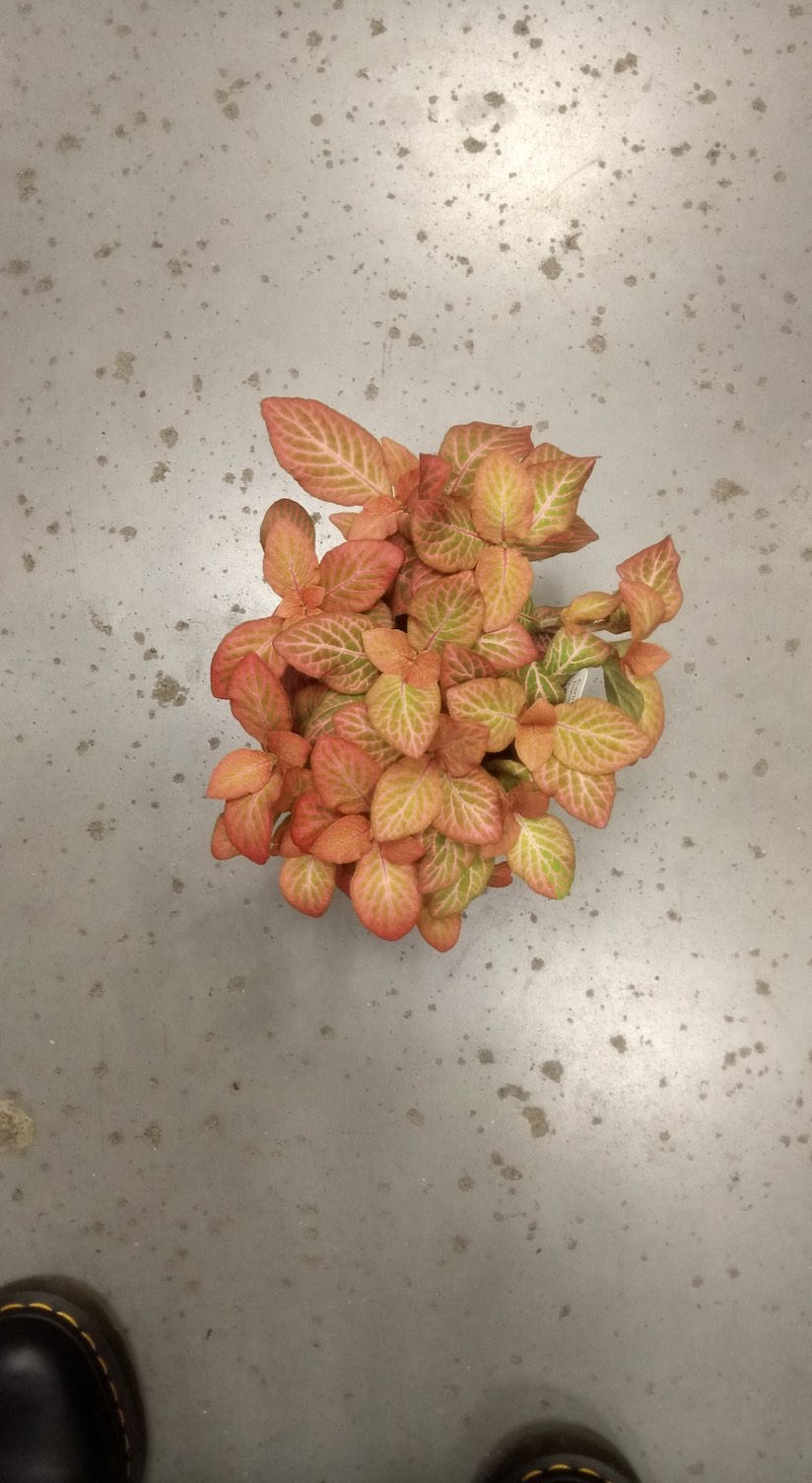
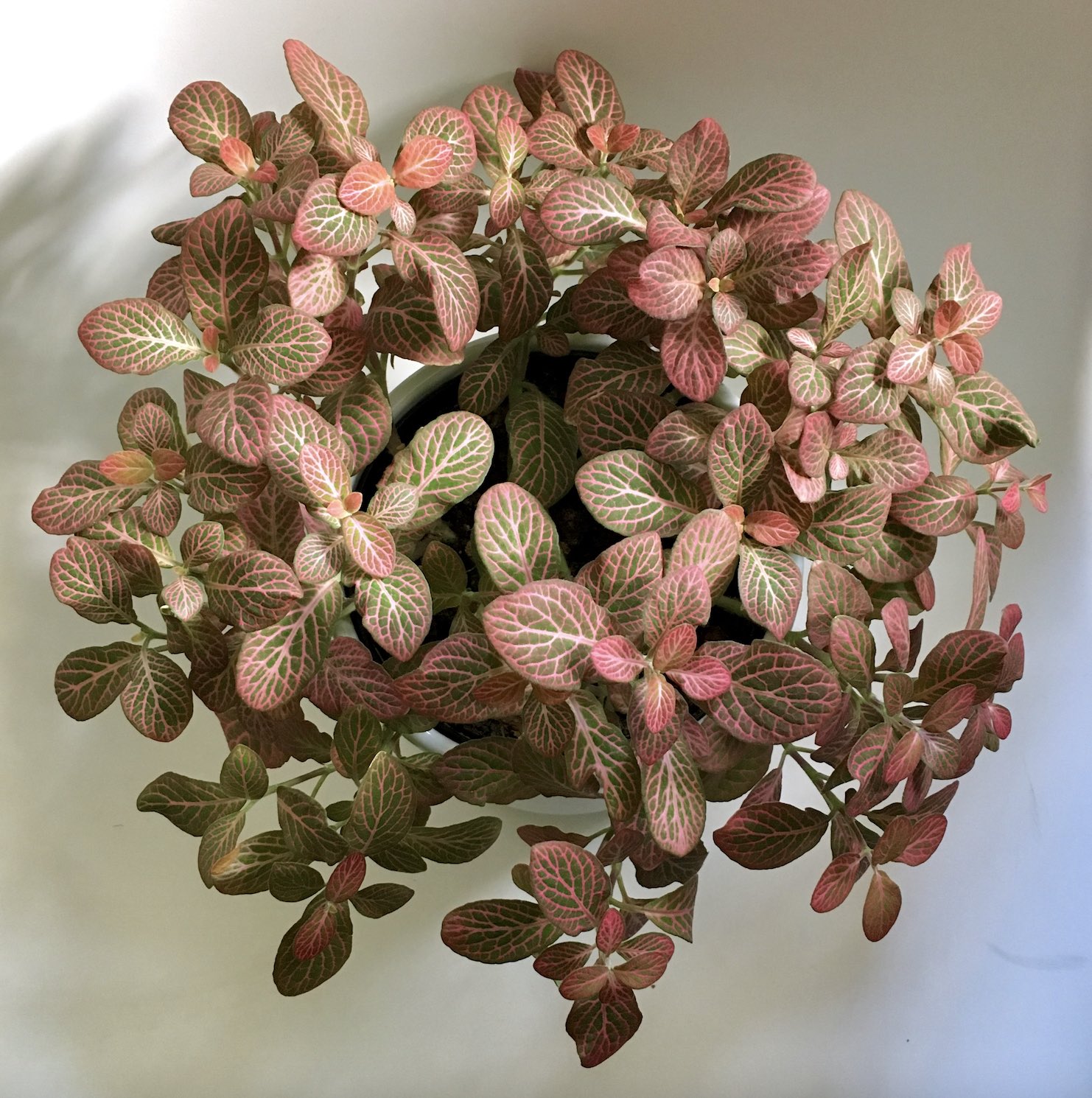
In this care guide we will be covering the topics of:
- light
- watering
- humidity + leaf care
- terrarium / cloche growing
- fertilising
- pests
- repotting
- potting mix (+ pots)
- propagation
- + flowering

LIGHT
With their paper-like foliage, Fittonia are not keen on a very bright position — their leaves will get easily scorched + yellowed if the plant is getting a light that is too intense. In their natural habitat of South America, they are a low-growing creeper + so are more amenable to indirect light conditions as a houseplant too. There are many cultivars in all shapes, sizes + colours, here are two growing in Botanic gardens: to the left is a photo I took in the Royal Botanic Garden Edinburgh which illustrates its growth habit well + to the right is a Fittonia gigantea, a large leaved cultivar I spotted in the Chelsea Physic Garden, with my hand for scale:
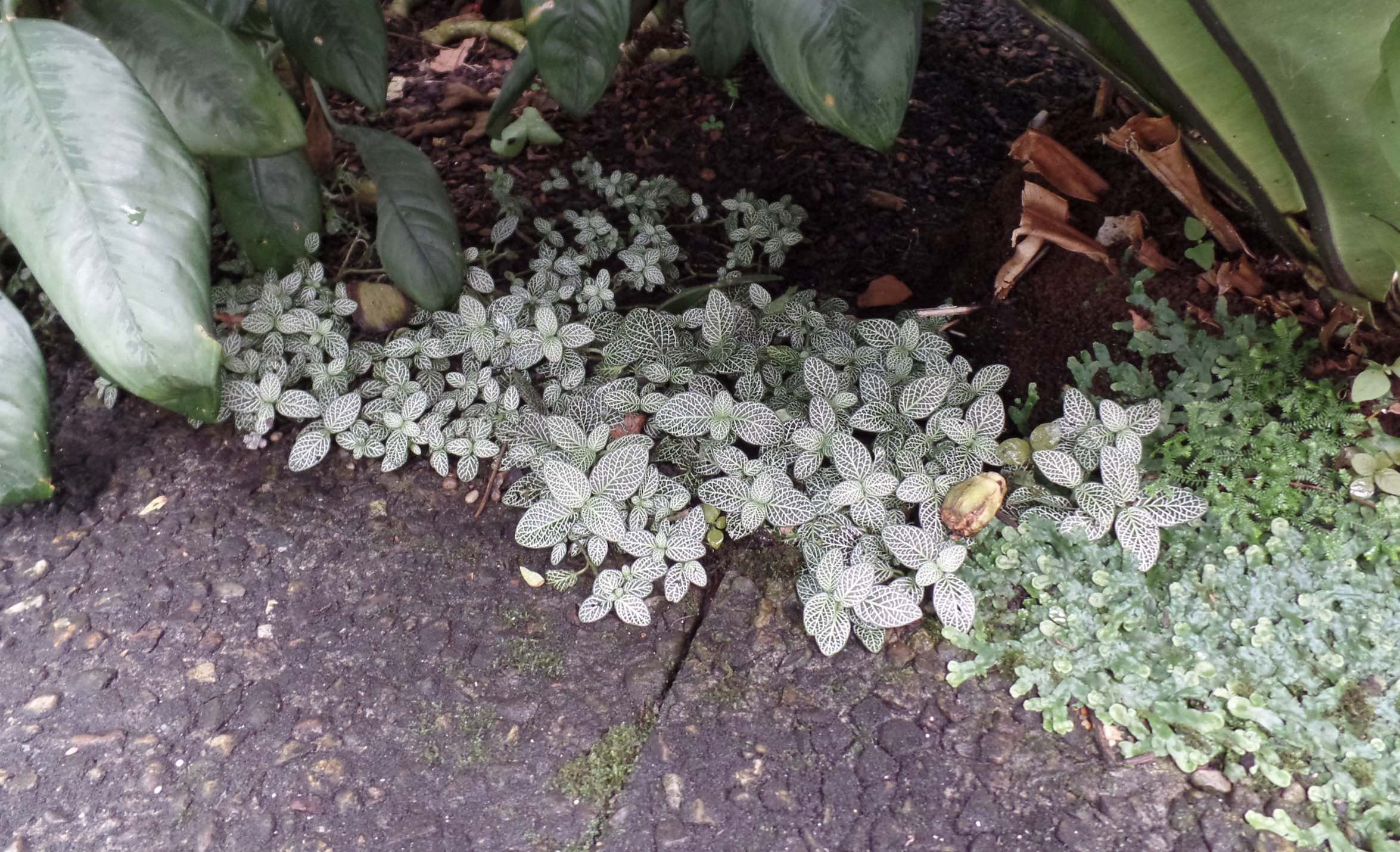
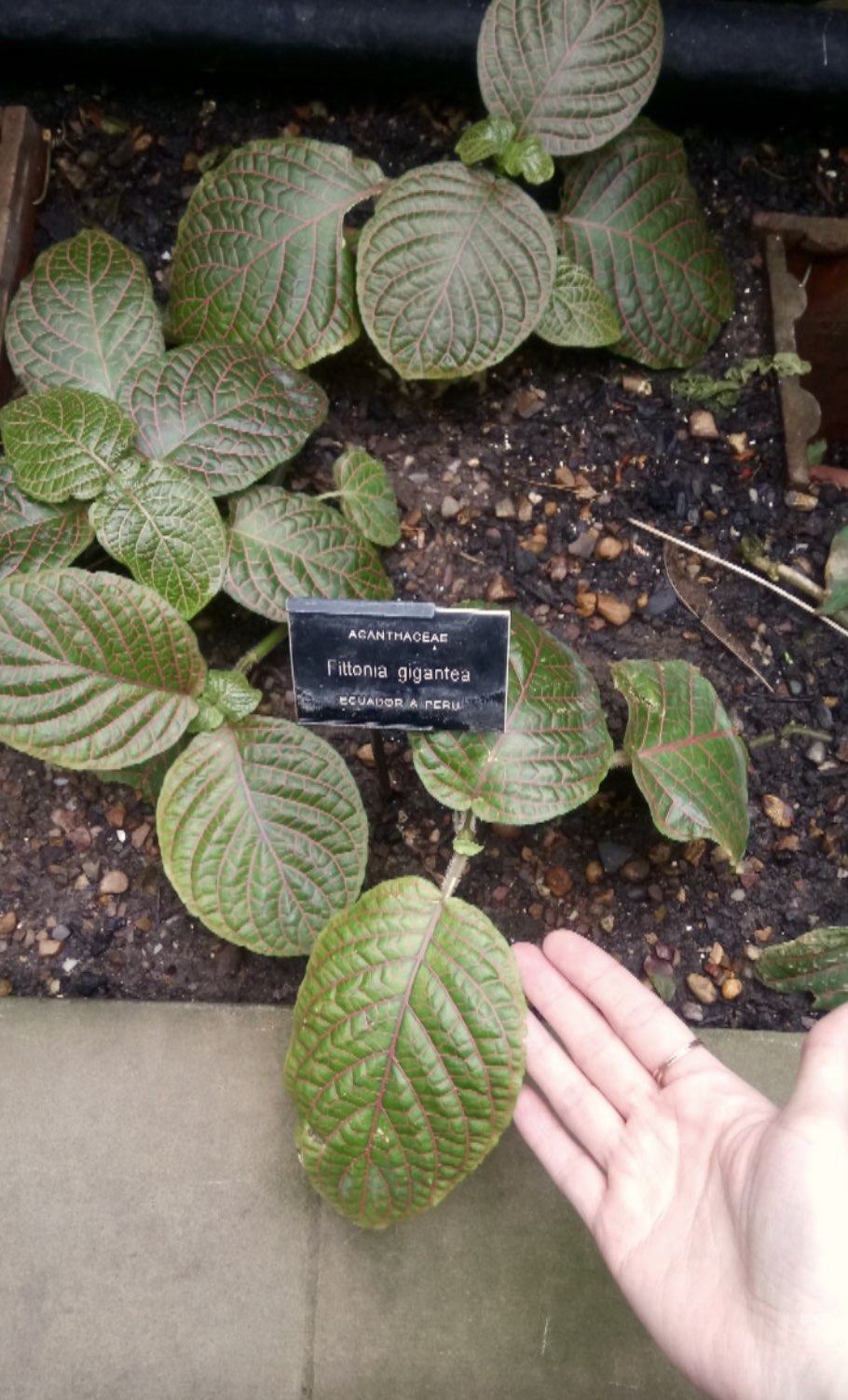
I grow my plant around 2 metres away from a North-western exposure (I’m in the Northern hemisphere FYI) + in my previous apartment, I kept it 1.5-2 metres from a south-western window. Your nerve plant will tell you if it is in a placement that is too dark as the stems will stretch up — literally looking for more light. Over time, these plants can start to look leggy, but regular pruning can help + if you keep it in a pot, be sure to rotate it regularly to keep the globe-like form, otherwise the growth can start to look quite unkempt. I think this is also the reason a lot of nurseries sell these as juvenile plants — because let’s face it, they do look prettier in a little pot!
In terms of leaf appearance, in a brighter spot, you might notice the leaves take on a more intense hue, whereas in a shaded location, the veining, particularly of the coloured varieties, can fade. This also happens seasonally, so your plant might look more washed-out in Winter. For me, I think my Fittonia looked better in colour in my old apartment as it enjoyed a slightly brighter position, but the indirect, yet warm afternoon western light during Spring + Summer in both locations works well + when I move I’ll try to replicate this if possible. As with all houseplants, avoid draughts + heaters at all costs!
Remember that these are the conditions personal to my own current environment + are used as a guide for you to compare with your own home. Things like light intensity can fluctuate dramatically throughout the year which is why you might find yourself moving your plants around in line with seasonal shifts. Location + light intensity are also intrinsically connected to more environment-based concerns such as the size + positioning of your windows, whether or not you have other buildings close by, or if there are obstacles like trees outside. This is something to take time to understand in your personal space — I have really noticed these factors in this temporary cottage because I’d previously been used to larger sash windows in my old second floor apartment, whereas here, the light is intense at the front of the house coming through the smaller leaded windows, before tailing off quite severely (not my windows of choice but I’m working with it for now).
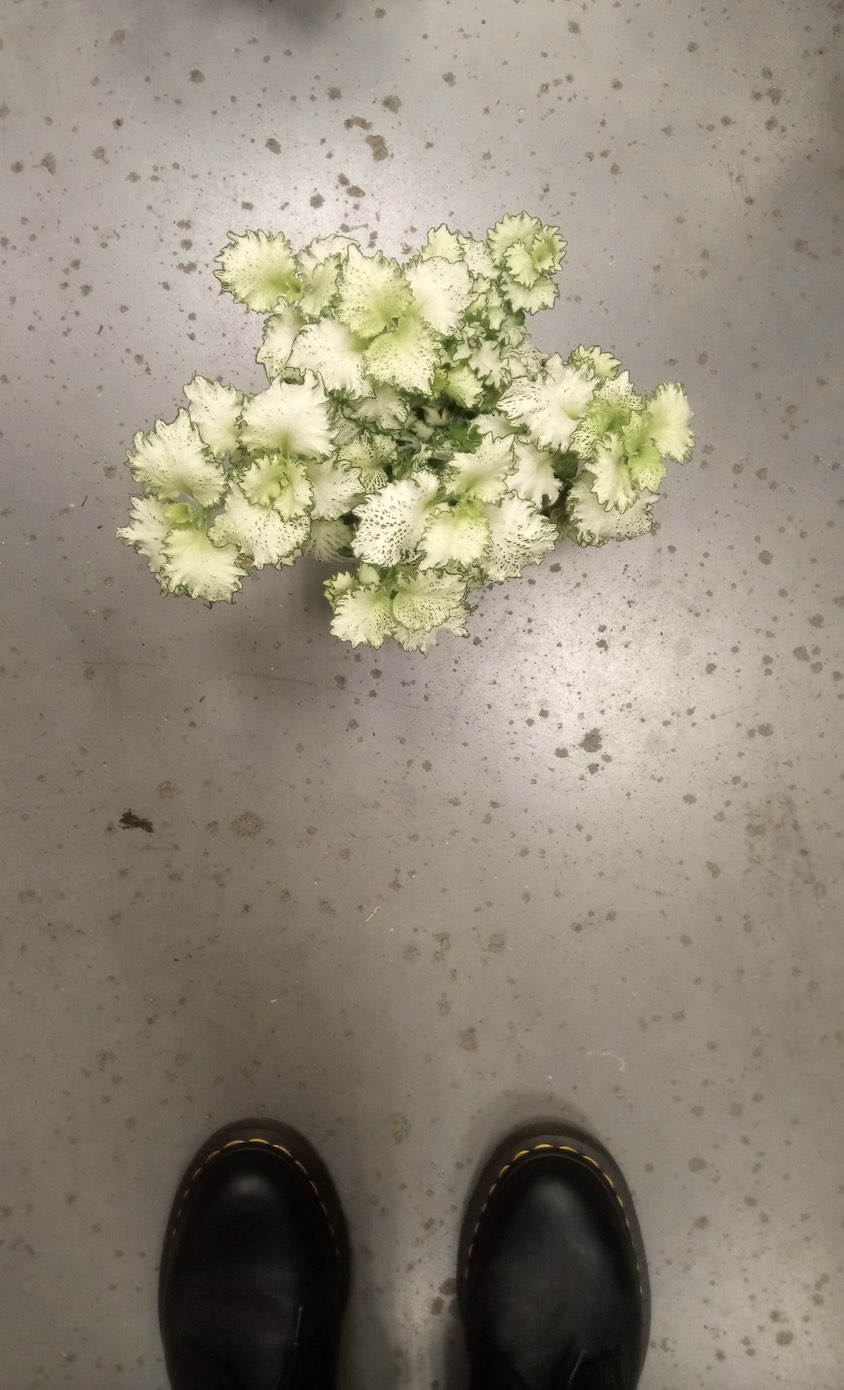

WATERING
This is the main element of Fittonia care that can cause plants to shrivel up, never to return… or to wilt + collapse in an overly dramatic way, as if in an amateur theatre performance! Watering, or more, lack of watering, is the number one cause of Fittonia death, followed closely behind with overwatering. Consistent watering is the best way of keeping your Fittonia happy — I water my plant when the top inch of potting mix has dried out.
Let’s start with under watering — most of us that keep these plants will experience their fainting spells if we are a little slow to pick up the watering can at times. I’m actually amazed how much my plant bounces back after a bit of neglect, but only to a point. If the potting mix is left to dry out completely, there is little hope for resuscitating your plant.
At the other extreme, overwatering is another problematic encounter for a nerve plant because the stems will start to soften, the foliage will take on a yellow, sickly tone + start to wilt. As you might expect, if caught in time, under watering can be remedied by gradually increasing watering frequency until you find a happy balance with your plant, but it’s harder to correct overwatering. If you suspect you’ve been overwatering + your plant looks unhappy, have a closer look to see if any parts of the plant still have firm stems. If this is the case, you might be able to save a clump by propagation by division. More on that later.
In terms of watering technique, I use a combination of two methods for my Fittonia. The first method is to place the nursery pot in a bath (removing any cache pot) + use the shower head to flush water through until it runs out of the bottom of the pot. I’ll leave the pot to sit here for 20 mins or so so that any excess water has properly drained away before putting it back in the planter. At the same time, the leaves will also get a clean (see below). But be careful to test the temperature of your water first! Tepid is always best + anything very cold can shock your plant. The other method concerns using my trusty watering plate + watering from the bottom (see below). I put my pots on a large flat plate or drip tray + water the plate, before leaving the pots on there for around an hour. On average, I tend to do this every 2-3 waterings, then give the plant a flush through the next time.


HUMIDITY + LEAF CARE
Coupled with watering, humidity can be a challenging aspect of nerve plant care. If you live in a home with low humidity + are looking for a pretty plant to display on your table, this is not the plant for you. I’ve always lived in old buildings with high humidity of around 60-70% so I have been able to grow this plant considerably well with no external intervention, like a humidifier.
To keep the foliage looking its best, I give my plant a shower every few weeks to clean any residual dust + pay particular attention to where the leaves join the stem as this can be a potential area where pests can congregate if dust builds up.
The increased humidity needs mean that plant lovers that really want to keep this plant in a regular household environment, might choose a terrarium as a home for their Fittonia or to make a potted arrangement with a couple of plants with similar care needs. My mum was gifted a planter a few years ago + it’s still doing amazingly well despite no special care. The fittonia is snuggled up with a (small!) parlour palm, trailing ivy + a peace lily + has grown slowly but steadily in a creeping form + looks really good around the base of the others! As they are huddled together, the plants will create their own little eco-system which is why multi-planting can really work well in this way. Aside from in terrariums, houseplants aren’t used to make arrangements anywhere near as often as they were in the 1970’s + 1980’s. This planting style waned in popularity but with the increasing interest in houseplants, I wonder if this approach will become popular again, particularly as many of us are living in smaller homes…
TERRARIUM / CLOCHE GROWING
Growing Fittonia ‘under glass’ is an option if you like humidity loving plants + really want it to thrive. There are a number of options here — ranging from a cloche/bell jar over the pot, a propagator, to a makeshift humidity dome using a clear plastic bag with holes in. If you have the space, a terrarium display can work really well for these plants. Terrariums are a popular addition to many homes of houseplant lovers + are a great way of being able to keep humidity loving plants happy + thriving. On a larger scale, a glass ‘greenhouse cabinet’ set up like those you might have seen on social media works if you are looking to grow a lot of tropical, humidity loving plants. This is more advanced but worth knowing about if you are interested.
Terrariums out of old fishbowls or vintage glass vessels can look fantastic and the diffuse light through the glass suits nerve plants so well. Their creeping growth habit is likely to really take off here + will likely find your plant taking this sort of shape, rather than a rounded form as they often look as pot plants. I’ve also seen some very small Fittonia cleverly planted with long tongs in a bottle garden which was left to grow wild!
Remember that with increased humidity, the watering needs will be reduced + in a closed situation like a cloche, you might even not need to water at all. When my Fittonia was younger, I tried keeping it under a glass dome + its watering needs were greatly reduced.
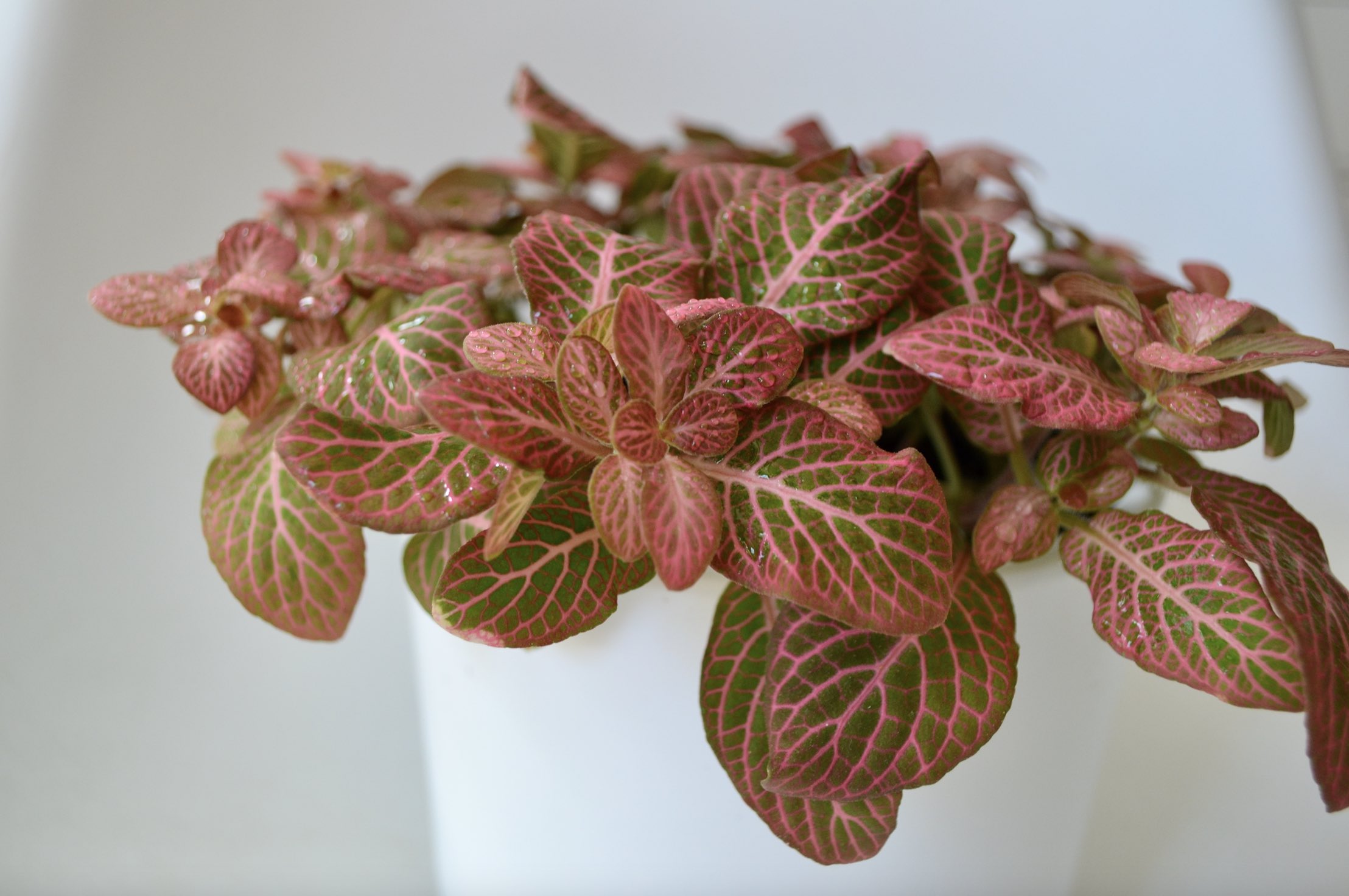
FERTILISING
Nerve plants are slow growing houseplants + can cope well without the need for regular feeding. Between March + October I fertilise around once a month with a balanced liquid houseplant fertiliser at half the recommended dilution rate. If your climate is quite different to mine + you find your plants grow year-round, then more regular fertilising is fine. The easiest way to judge whether or not to feed is if your plant has new leaves growing! Fertilising can help to keep the plants more resilient + given the right conditions of course, provide them with the best chance of flourishing.
PESTS
Incorrect care + a sustained lack of humidity can cause problems for your nerve plant, which might suffer a pest attack in these adverse conditions — be mindful of warm temperatures + dry air. A consistent care routine helps keep your plant resilient to pests, alongside a monthly feed when they are growing.
Mealybugs can appear on a very neglected Fittonia so keep an eye out for fluffy white deposits where the leaves join the stem, or on the undersides of the foliage. If the attack is small, these can be wiped off with a cotton swab coated in rubbing alcohol + monitored. But as the leaves are very delicate, you could face problems reviving the plant. Overwatering can sometimes invite fungus gnats to fly around + breed in the potting mix, which sounds a little grim, but if you suspect fungus gnats, these sticky papers are an excellent way of beginning to tackle the situation. If you have a lot of houseplants, be aware that this can escalate to a number of pots quickly + can be hard to police. Prevention is better than cure of course, so try to avoid overwatering or a very dense potting mix, coupled with very low light conditions. Spider mites in very dry conditions are also a possibility in low humidities coupled with infrequent watering, though your plant will likely show you it’s unhappy in this environment, before a pest has time to attack!
After any treatment, I like to use SB plant invigorator either as a ready to use spray, or you can also get a concentrated bottle to dilute into a spray bottle yourself, be extra careful on more delicate foliage + always test a part of the plant first.
REPOTTING
Fittonia don’t have a large root system + much like the plant itself, the roots themselves are delicate too. This means that they don’t require regular repotting — I’ve only repotted mine twice in around 3 years I think! A rookie error of repotting into a larger pot to encourage it to grow bigger won’t help your fittonia + will likely just cause it unnecessary stress. Keep a look out for the roots starting to run around the bottom of the planter, or if you notice that your plant is starting to crisp at the leaf edges + is ‘fainting’ or requiring watering much more frequently than usual. I generally only re-pot when the plant has a period of active growth ahead — so from March onwards in my case, with Spring + Summer ahead.
When you are planning to re-pot, it’s a good idea to water your nerve plant in the few days before repotting because manipulating a very dry plant can sometimes cause transplant shock. As you remove the plant from the pot, be gentle with the roots as you loosen them with your hands, shaking off any old potting mix. Despite not needing repotting often, these plants will really benefit from new potting mix when they are repotted. And only go up one pot size at a time, no drastic jumps!

POTTING MIX
For potting mix, I like to make up a concoction of peat-free houseplant potting mix, orchid bark + some perlite — here’s the link to the base mix I like to make up, with links. I will often add some sphagnum moss into the mix too, or also add a layer to the top of the pot to help keep the moisture in + the soil temperature up. This is also good tip if you are prone to under-watering your fittonia! If you are using this substrate please make sure you buy your Sphagnum from a reputable source.
A NOTE ON POTS: It sounds obvious but the type of pot you choose to use is also connected to your mix + watering requirements. In my experience, Fittonia are better suited to nursery pots + as with other humidity loving/ more frequent watering houseplants, I find they dry out far too quickly in terracotta. Terracotta is much more porous + will wick the moisture away from the plant. If you want to use terracotta for display or plant styling reasons, you can always use the terracotta as a cover (cache) pot.
PROPAGATION
Propagation by division is the most popular method for Fittonia + a good way to create a new pot or to grow your collection on. As they are slow growing, creeping plant, new stems will emerge at the base of the pot which will create a fuller plant over time. Alternatively, these stems can be removed + planted in a new pot if you desire, but it’s always best to use parts that have started to establish roots. When taking cuttings, be sure they are a few inches long + that there are some nodes present.
I’ve not tried taking cuttings of my fittonia yet to root in water, but as you might imagine, this process can be slow. In either case, using a propagator to keep the humidity up, or a makeshift humidity dome with a clear plastic bag with holes in can create a favourable environment for your small plant or cutting to have the best chance for survival. Plants can also be grown from seed but this is less common.
FLOWERING
As a houseplant, Fittonia don’t often flower + when they do, admittedly they are not all that interesting — their foliage definitely steals the show! You can choose to pinch out the spikes if they do appear though, because their growth does divert energy away from the plant. But here is a photo I took of a flowering plant in a display at Chelsea Physic Garden. Side note: A ‘HPH visits…’ post about this place will be up in a few weeks if you wanted to see more.
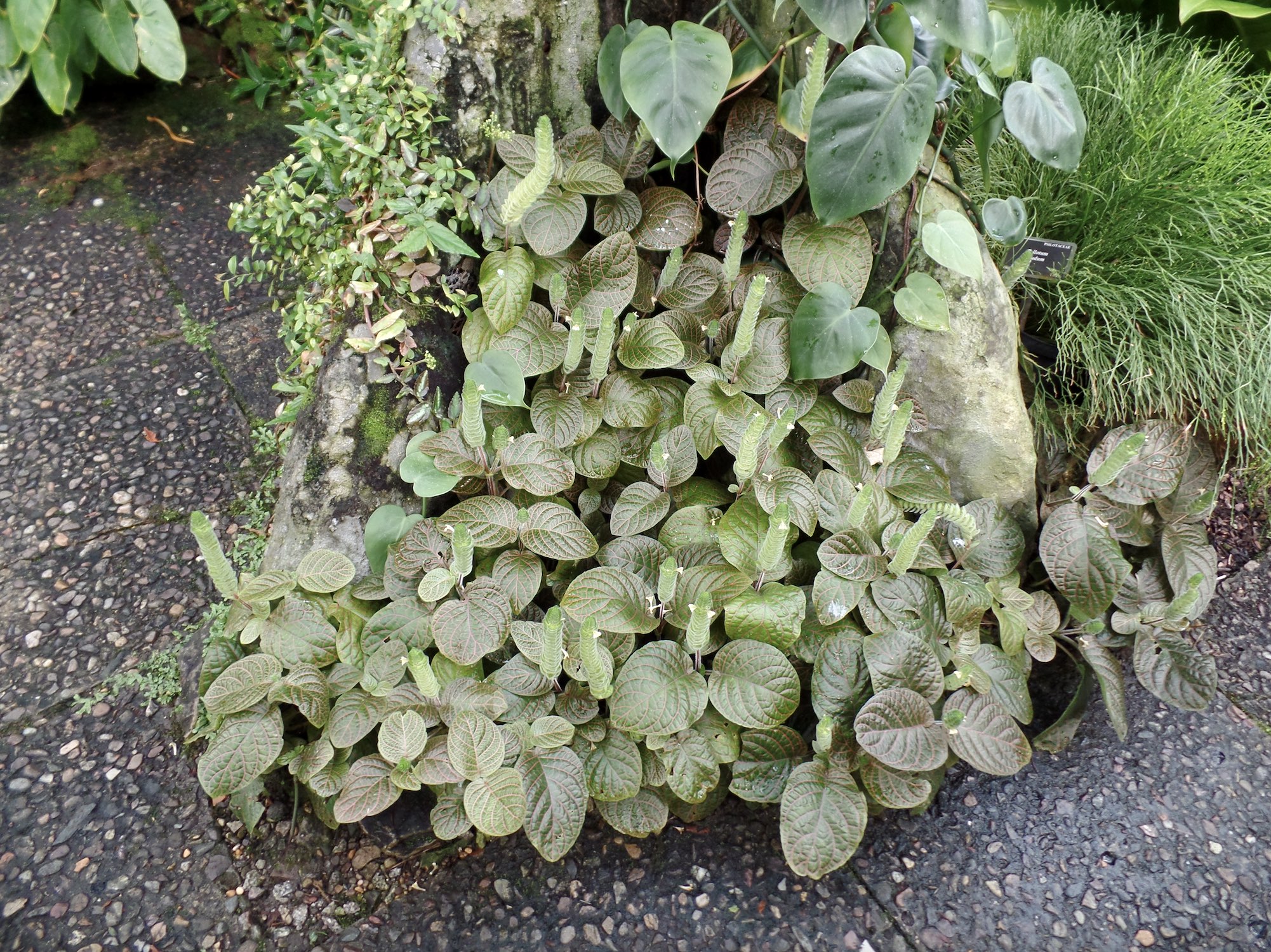
Thanks as always for your blogpost requests — it’s really helpful to hear what you want to see here on HPH + there’s a new post every week. I hope you enjoyed reading about how I care for my Fittonia + that it might have given you some tips for keeping your plant happy at home. They aren’t the easiest of plants so try not to feel too disheartened if you struggle with yours at first, but getting their care right can be so rewarding as these leaves are pretty special to have around.
This post is saved under my ‘Plant Care Guides’ on my homepage if you want to refer back to it + here are some pins to share or save too:
*Affiliate links are used in the post which means I can receive a (very) small amount of commission if you make a purchase — thank you for supporting my blog. I often get asked where I get specific items from so have linked these here. I have bought all these products with my own money.


Leave a Reply